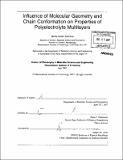Influence on molecular geometry and chain conformation on properties of polyelectrolyte multilayers
Author(s)
Zacharia, Nicole Suzan
DownloadFull printable version (37.75Mb)
Other Contributors
Massachusetts Institute of Technology. Dept. of Materials Science and Engineering.
Advisor
Paula T. Hammond.
Terms of use
Metadata
Show full item recordAbstract
The layer-by-layer (LbL) method of self-assembly is a versatile technique for fabricating thin polymer films. This thesis compares the properties of LbLfilms composed of different weak polycations. Slight perturbations in film assembly conditions can lead to large differences in film properties. Polyion bacisity and architecture are less understood variables. The polycations used are of similar chemical composition but different molecular geometries and basicity. Films studied were composed of poly(acrylic acid) (PAA) in combination with linear poly(ethylene imine) (LPEI), poly(allyl amine hydrochloride) (PAH), branched poly(ethylene imine) (BPEI), or poly(amidoamine) (PAMAM) dendrimer, generation four, amine surface. Various properties of these films are compared; including film thickness, chemical functional group availability, and film composition. Carboxylic acid group ionization is found to increase with assembly pH, and PAA content is found to decrease. PAH, the most basic of the polycations, forms films that are the thinnest and the most ionized while PAMAM films have the most free free acid groups and form the thickest films. (cont.) Permeability to chloroethyl ethyl sulfide vapor was seen to correlate with film ionization and therefore ionic crosslink density; diffusivity was highest in films that deposit in "loopy" layers and solubility was highest in films with the highest degree of ionization. The diffusion of these polycations (specifically in the direction of film growth) is shown to be able to disrupt LbL heterostructures. A model system of a strong polycation (here poly(hexylviologen)) and PAA was used to show rejection of PXV in favor of a weak polycation, given that it was only partially charged.. Direct correlation between polycation charge density and ability to diffuse throughout bulk film was seen; polycations that are fully charged will simply adsorb to the surface while partially charged chains are mobile. Based on these observations, a strategy for creating compartmentalized heterostructures by inserting fully charged layer pairs was developed. Two different drug delivery strategies were examined; encapsulation of block copolymer micelles in LbL structures and then electrochemically responsive films using Prussian Blue (PB) nanoparticles. Micelles are able to provide a hydrophobic environment within an LbL film, making these films useful for delivery of small molecules.
Description
Thesis (Ph. D.)--Massachusetts Institute of Technology, Dept. of Materials Science and Engineering, 2007. Includes bibliographical references.
Date issued
2007Department
Massachusetts Institute of Technology. Department of Materials Science and EngineeringPublisher
Massachusetts Institute of Technology
Keywords
Materials Science and Engineering.